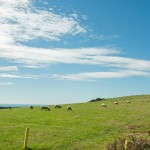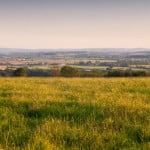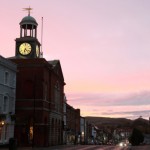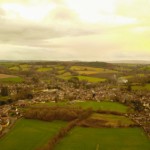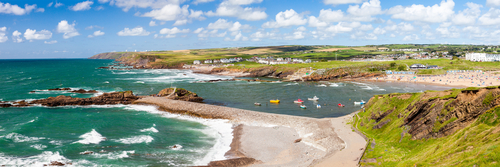
Bude – in five minutes!
Bude Haven, better known as just Bude, is a small seaside town on the Celtic Sea in the extreme north-east of Cornwall, south-west England. The town is just 2 miles (3 km) west of the small market town of Stratton with whom it shares a civil parish. Situated about 19 miles northeast of Tintagel and 34 miles southwest of Barnstable, Bude lies at the mouth of the River Neet (aka ‘the Strat’), just north of Widemouth Bay. During the 19th century, Bude was famous for its unique canal. At the 2011 National Census, the population of Bude was 5,091, with that of the wider civil parish of Bude-Stratton being 9,222.
A Fleeting History
Archaeologists believe that Bude was settled as early as the Bronze Age. During the Middle Ages, Efford Manor, the baronial seat of the Arundell family was the only building in Bude. Sometime during the 18th century, the land around Bude owned by the Arundells’ transferred to the ownership of Acland family. Yet still, the Bude area remained sparsely populate, having had no more than a hundred inhabitants at the turn of the 19th century. However, all this was about to change with the coming of the ‘Bude Canal’.
In 1811, Sir Thomas Acland received a large inheritance and began looking for a local investment opportunity. He came up with the notion of financing the Bude Canal, a proposition that had been conceived some 35 years earlier by Cornishman, John Edyvean. The main thinking behind the project was to excavate and transport the lime-rich coastal sands inland utilising the canal. The soils were to be used to enrich the mainly acidic and infertile soils of the surrounding farmland much more productive. Additionally, the transport of other commodities, such as coal, slate, timber, iron and bricks could also be facilitated, while farm produce could make the opposite journey for export.
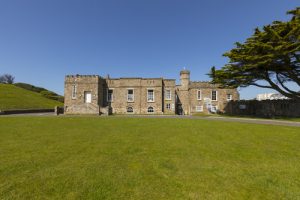
‘The Castle’ at Bude was built in 1830
Acland soon had other investors onboard who saw the potential of the opportunity, this included Phillip Henry Stanhope, the 4th Earl Stanhope, who would later achieve notoriety as the guardian of Kaspar Hausar. In 1819, the Bude Harbour and Canal Company was formed and work soon began on both the docklands and waterway. The 35-mile canal to Launceston was fairly unique in that rose from sea level to an altitude of 433 feet (132 m), using a system of ‘inclined planes’ rather than locks. It was completed in 1826 at a cost of around £125,000 (some £12.5 million today – 2020).
The canal was never to realise the financial success its owners had hoped as constant engineering problems and revenue deficits kept the company constantly short of money. However, the presence of the canal gave Bude much better connectivity to the likes of Bristol and Exeter making travel and trade much easier. This meant Bude was now a much attractive place to live.
In 1830, The Castle, a castellated mansion overlooking Summerleaze Beach was built by Sir Goldsworthy Gurney. In 1835, the town’s St Michael & All Angels church was founded, being consecrated on 29th September. In 1836, the parish of Bude Haven (aka Budeham), was created from part of the civil parish of Bude-Stratton. In 1841, the population of the parish of Bude Haven, which had been bolstered by workers who had remained in the area after building the canal, peaked at 2,431, which was double what it had been in 1801.
The coastline off Bude has long been known to mariners as a potential hazard with many ships running aground on its jagged reefs. In 1862, the most infamous of all Bude’s shipwrecks, the Bombay bound three-mast cargo ship ‘Bencoolen’, ran aground close to shore during a massive storm. Because of the storm, the town’s main lifeboat couldn’t be launched, resulting in 29 of the ship’s crew of 33 being drowned. The ship’s figurehead is on permanent exhibition at ‘The Castle’ in Bude, and the ship’s bell; at the Methodist Chapel of nearby Roscarrock. The Bencoolen entered into Bude folklore and today there is a road, bridge and public house, as well as a number of residential houses in the town, named after the infamous ship.
In the second half of the 19th century, Bude became a favoured seaside resort of the Victorians, being viewed very much as a romantic retreat. Initially, a norm for the times, segregation of the sexes was imposed, ladies used Crooklets Beach, while gentlemen had to use Summerleaze. The famed Bradshaw’s Guide of 1866, described Bude as “a small port and picturesque village”. In 1898, Bude’s popularity as a seaside destination increased when the London and South West Railway (LSWR) extended the existing branch line between Oakhampton and Holsworthy to the town.
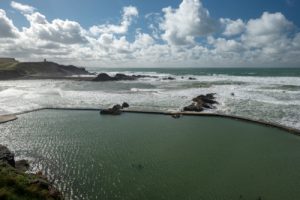
A view of the ‘Sea Pool’ at Summerleaze Beach
However, the arrival of the railway wasn’t good news for all, especially the canal owners. Just as the canal was beginning to reach its full potential, the railway, along with the recent availability of cheap fertiliser, was to destabilise its commercial viability. In 1901, the canal was closed and sold off to the district municipal water company. The wharf area and harbour managed to enjoy a somewhat longer commercial life in catering for coastal sailing ships transporting grain to Wales and returning to Cornwall with coal.
Between 1841 and 1891 the population of Bude Haven shrank by around 9% to 2,212. However, by 1901, the population of the parish had climbed to 2,788, representing almost 20% growth over the preceding decade. In the early 20th century, shipping to Bude’s harbour began to dwindle rapidly as the railway began to dominate. Thus, the town was left to concentrate on its emerging tourist trade. Consequently, by 1926, the small seaside town of Bude had 59 boarding houses and 5 hotels. In 1930, Bude’s famous sea pool was built amongst the natural rock at Summerleaze Beach.
At the start of World War II, the site housing GCHQ Bude, located about 5 miles from the town at Morwenstow, was developed by the RAF. It was part of the RAF Cleave complex, which was home to 639 Squadron from April 1943, until it was disbanded at the end of the war. In 1945, the airfield was put under long term maintenance and remained under government ownership.
In 1964, the Atlantic Coast Express service, which provided a direct rail link from London’s Waterloo to Bude was discontinued. On 1 October 1966, Bude railway station, along with the rest of the branch line to Oakhampton, was closed as part of the ‘Beeching’ cuts.
In 1974, following the countrywide local government reforms, the civil parish of Bude-Stratton District Councils was recreated, along with a town council.
The Modern Era
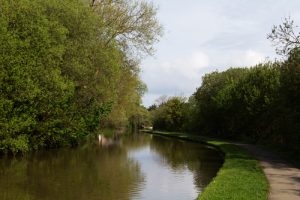
A view of the restored section of Bude Canal
In 2006, the £5 million Bude Canal Regeneration Project began work on the restoration of the first two miles of the canal i.e. from the sea lock to Heybridge. The work was completed in 2009.
Today, while tourism is the main industry in Bude there is still some fishing carried out. There are around 20 small fishing boats which use the harbour during the summer months. While most are sports fishermen there are a few semi-commercial vessels that fish for crab and lobster. The largest employer in the area is GCHQ Bude, with over 250 civil servants and contractors at the Morwenstow site.
There are lots of festivals and fetes held in Bude over the summer months. One of the most anticipated events in the Bude calendar is the Bude-Stratton Heritage Festival, a celebration of Cornish ingenuity, which is held in July on an annual basis. However, the town’s major event is the annual Bude Lifeboat Weekend which is usually held across the 3 days of the August bank holiday.
Bude is twinned with Ergué-Gabéric in Brittany, France.
Did you know?
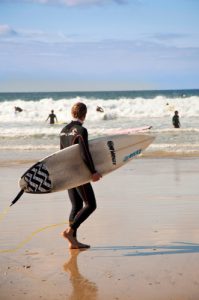
#Bude is renowned for good surfing
- Facing the Atlantic Ocean, Bude is renowned as an excellent location for surfing.
- Formed in 1953, Bude Surf Life Saving Club was the first of its kind in the country.
- Bude has the only manually operated sea lock gates in England.
- Bude gets more sunshine than most places in the UK. In 2013, it was found to be the sunniest place in the country.
- ‘Bude Tunnel’ is a 70 m long perspex walkway. Built at the local branch of Sainsbury’s in 2018 it’s now one of the town’s top tourist attractions.
- There are eight beaches within a few miles of Bude town centre
How to get there!
By car
For most drivers, the best way of getting to Bude will be to take the M5. Leave the M5 at Junction 27, then take the A361 for Barnstaple. From Barnstaple turn onto the A39 towards Bideford. Bude is another 25 miles further on from Bideford. Alternatively, you could stay on the M5 to Exeter, then take the A30, A395 and A39.
By Bus
National Express operates a frequent direct bus service from London Victoria to Exeter bus station. From there, the 6 and 6A local bus service will take you to Bude. The 54-mile (86 km) trip takes around 2 hours on the road but extra time for stops and/or transfers at Oakhampton and Holsworthy usually brings the overall journey time to around 3 hours.
By train
The nearest train station to Bude is Exeter St David’s. The fast and easy way to get there by train is to take the London Paddington to Penzance line. From Exeter St David’s take the 6 or 6A local bus service (See above).
By Air
Bude is about a 40-mile drive away from Newquay Airport. There are currently 9 airlines that fly to and from Newquay Airport. There are also regular flights to and from London. The next nearest airport is Exeter which is about 64 miles away.
Getting around!
There are regular bus services between Bude and Boscastle, Tintagel, Camelford, Newquay, Padstow, Truro and all places in-between.
Sport
Bude RFC
Founded in 1966, Bude RFC is amateur rugby union team that plays in the Cornwall & Devon League. They play home games at Bencoolen Meadows.
Bude Town FC
Founded in 1901 and known as ‘the Seasiders’, Bude Town is an amateur football club that plays in the Southwest Peninsula League. The team plays its home games at Broadclose.
Notable residents

##Tori Amos has a house in Bude
- Rennie Montague Bere (1907 – 1991) – was a renowned British mountaineer, naturalist, conservationist and author, who lived in Bude during his retirement.
- Sir Laurence Dudley Stamp (1898 – 1968) – was one of Britain’s leading 20th-century geologists and geographers, who lived in Bude during his retirement.
- Sir Goldsworthy Gurney (1793 – 1875) was an English surgeon, chemist, lecturer, consultant, architect, builder and inventor, who lived in Bude during the 1830s.
- Tori Amos – famous American singer-songwriter has a home and recording studio in Bude.
Things to see and do!
A few recommended things to see and do around Bude, are:
- Summerleaze Beach – is a clean, open, sandy beach less than 5 minutes walk from the town centre.
- Bude Sea Pool – created in 1930, is part natural, part man-made, 91 m long x 45 m wide, swimming pool in the rocks at Summerleaze Beach.
- Big Blue Surf School – based on Summerleaze Beach, they have 15 years plus experience teaching novices to surf.
- Tamar Lakes – close to Bude, the Upper and Lower Tamar Lakes offer a variety of activities including watersports, angling and walking.
- The Castle – displays objects and has exhibitions related to the history of Bude – Stratton and the surrounding area.
- Bude tunnel – found in Sainsbury’s car park, the spectacularly lit, perspex, metal-framed tunnel is one of Bude’s top tourist attracts.
- Red Elk Archery – affords the chance for archery newcomers to learn the sport in a safe environment. Sessions at the all-year-round facility generally last 3 hours.
- Bude Canal – Canoes, kayaks, pedaloes and bikes can all be hired to navigate the restored 2 miles of the canal. There is also fantastic coarse fishing at the waterway.
Where to stay?
There’s a limited amount of accommodation in Bude itself although the surrounding area obviously offers more options. In Bude and the general area expect to pay something around the following for accommodation for 2 adults sharing:
B&B/Guesthouse/Lodge: £80 – 130
Hotel: £130 – 170
NB: Photo credit – #Obs 70/##Featureflash Photo Agency//Shutterstock.com

